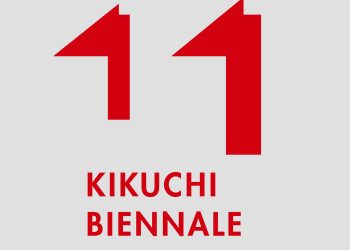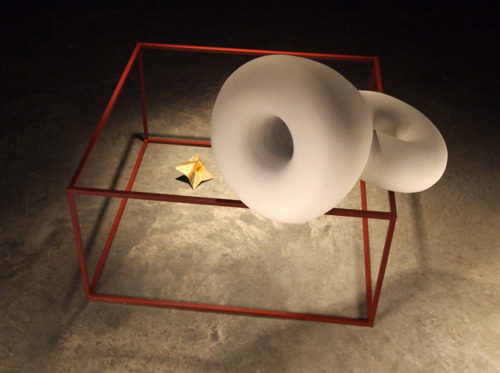
You are a very creative artist, working with large scale installations, ceramic objects, sculptures, vessels and various drawings. When do you have time to transpose all your emotions and ideas into them?
Thank you. I obsess about ideas. My methodology for making, for creating, has me developing many works at the same time, not just in the beginning phases, the thought process, but also during the construction phase. Mold making, throwing, painting, welding, drawing, functional, non-functional—everything that happens, it all develops simultaneously. I enjoy working right up to, and, sometimes, past my limit. I view making work on all of these different platforms, using different materials, and incorporating as many ideas as I can ideas, in the same way, that I see conversations. Each day I have vastly different types of conversations with many different people; from humorous to serious, political to chit chat and minutiae. When an idea surfaces, the process may demand a particular size, finish, or material. Following the concept, and its needs supersede the necessity of conforming to a particular style or material.
As a father of two, husband and professor, it is difficult to manage time. My wife, Lori, who is not an artist, has an amazing tolerance for the creatively obsessed mind. If it were not for her support, I would never find the time to work on so many projects. Working with clay, I can take advantage of the timing/drying constraints, and toggle between works, maximizing my available studio time. I have also recently taken on an assistant, Eli Blasko, to help better manage my time so that I can focus more in the studio.
How do you see this relationship between idea/intuition and the final work itself? Is it always continuous or sometimes gap comes through?
The final work is an entity all of its own. An idea starts the work and then intuition supports that idea during the development of the piece. I keep true to a cautious respect for the moment. While I’m in the process of working, my intuition may shift the work’s original intentions, or trigger a new idea(s) that can rearrange the work while I’m still in the process of making it. My idea can fluctuate as much as the physical object I’m making. Using this method, gaps occurs naturally, and when that happens, I embrace that.
Recently, you’ve worked in collaboration with Shreepad Joglekar at some installations. How this collaboration affected your work, what did you learn from these experiences?
We have worked on and off since 2005, having met originally during our time in graduate school. Shreepad is originally from Mumbai, India, and regardless of our culturally different backgrounds, we share very similar views on art, politics, theory, etc. He and I have developed a relationship toward making that’s evolved to the point that when we work together, we have an effortless exchange of formal understanding, as well as conceptual development. Additionally, we share a work ethic that I have only found in several other artists.
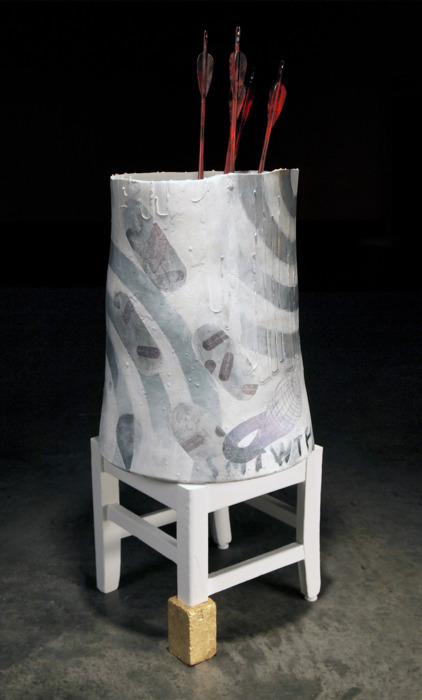
Our last exhibition, “Ergonomics of Futility” in Dallas Texas, was our first venture into a performance installation. This work was structured around complacency, inflation, futility, and politics. We descended on Dallas having had several previous conversations about content, and in two days, we created the entire show from scratch. Of the projects I have done with Shree, Ergonomics is the one I’m most proud of.
My most recent collaboration was with gunpowder artist, Ryder Richards. He and I developed a piece memorializing the NASA program entitled “Tribute to a Quarter Million Dreams”, which will be on display in the 2012 NCECA Invitational Exhibition in Seattle, WA.
In general, collaboration, for me, is an opportunity to relinquish total control of a work and to learn from an artist I respect. My hope is that they too get something from me. It is and has been an integral part of my creative research.
In 2009, I initiated the “Culture Laboratory Collective”, a collaborative group that explores experimental and traditional avenues of collaboration. With this larger format—we currently have twelve members—there is an exciting sociological component that surpasses a collaborative project with only one or two artists.
Shreepad Joglekar is Professor of Photography at Kansas State University.
Ryder Richards is Professor of Art at Richland College, Dallas Texas
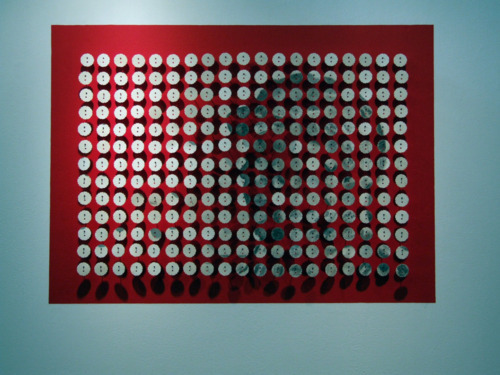
Shadowed
Discarded industrial porcelain, graphite, paint / 30x44x2 inches, 6bls
Tell us about the process of constructing a new work. How long does it takes, how do you start and what motivates you?
Some works come fast, and others take what seems like forever. Currently, I am developing a body of bottle/vessels that derive formally from 18th and 19th century hoop skirts. I start with gathering images and sketching. Then, for this project, in particular, I threw a couple of models, 10-12 inches in height. These models will inform the larger work. I quickly coil-built the larger finished form that I’ll mold later. Most of the time is spent in the leather hard stage, shaping and smoothing the original to cast later. This piece is roughly 24 inches in height. I made a mold of the original to be slip casted or press molded later. This method allows me to concentrate on the surface and less on the construction process.
To my best estimate from raw clay to molding takes 10-15 hours, spread out over a week. With the mold dried and ready, it is hard to say when I will have the finished work from it. I will cast many of them and exhaust different ideas with this form. I have been doing a very similar process with the capsule shape. I have several in the bisques state that I save and have waited to use. Just recently, I finished a capsule piece called, “Consumption,” and I’ve had that particular form for over a year before I figured out what I wanted to do with it.
Where can we see your works in the next future?
I will have work in the 2012 NCECA Invitational at the Bellevue Art Museum in Seattle WA. I will be in a few exhibitions this January, through the Spring: “ Co-Modify” at the Nave Museum in Victoria Texas, “Land Portrait” at UTSA Satellite Space in San Antonio Texas, a solo exhibition at Mansfield University in Mansfield Pennsylvania, a two-person exhibition at Brazo Gallery in Dallas Texas, and this summer I will be teaching a week-long workshop at Touchstone Center for Crafts in Farmington Pennsylvania.
A simple way to see what I am up to is to check my website http://www.ianfthomas.com/ . I try to keep it updated every few months.
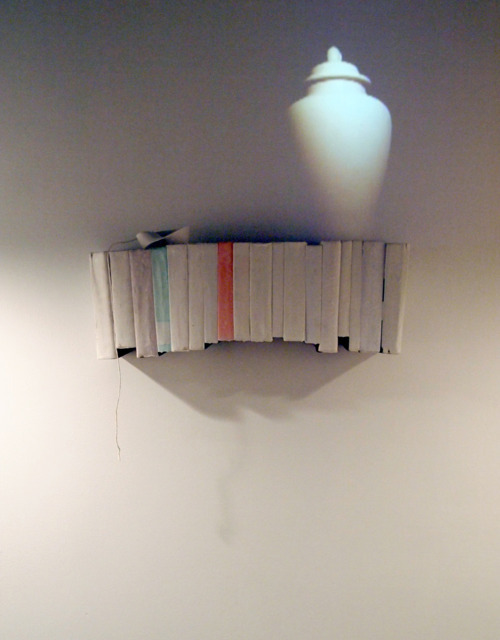
Turbulent Continuity
Digital Projection of a slip-cast Chinese vase (American made mold), 18 out-of-date educational books, slab-built earthenware, string, paint
“I have been making art objects for most of my life and I have found that I have a greater understanding of my work after making it. There is a mystery to things that people make. I choose the process of art-making as a medium to pose questions about my relationships with (art) objects, people and myself. Each time I start a work, regardless of the known impetus, the content of the work changes into something I didn’t previously know. I have been enjoying this unpredictability, lending my creative process to my intuition.” Ian F. Thomas
By Vasi Hirdo.
Published in Ceramics Now Magazine Issue 1.
Visit the Ian F. Thomas’ website.
View Ian F. Thomas’ profile on Ceramics Now.



